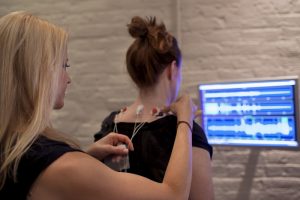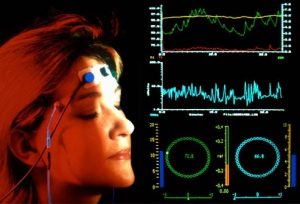Services Offered
BIOFEEDBACK
Biofeedback is a treatment technique in which people are trained to improve their health and emotional wellbeing using signals from their own bodies. Sensitive electronic instruments are used to detect physiological changes with far greater precision than a person can alone. This feedback or information is used by the biofeedback practitioner to teach the individual how to control the physiological reactions that can lead to illness or that result from physical or emotional trauma. It is a safe, natural, drug-free approach to treating many common disorders.
Biofeedback has been shown to be helpful in treating a wide variety of conditions, including:
 anxiety disorders
anxiety disorders- high blood pressure
- insomnia
- migraine and tension headaches
- TMJ pain
- chronic pain
- arthritis
- Raynaud’s syndrome
- immune system disorders
Biofeedback measures, either directly or indirectly, the physiology related to illness and provides moment-by-moment information to the individual so that the individual can learn to control physiological responses related to the illness. Many of these responses relate to changes in the body as a result of stress. When a person is in the stress response, muscle tension, blood pressure, heart rate and skin moisture increase. Blood flow to the extremities, digestion, and immune system activity decrease. By teaching the individual stress management techniques, including relaxation techniques, while providing feedback about physiological responses, the individual can quickly learn how to control his/her physiology. Over a number of sessions, individuals learn to master relaxations skills, not only in a quiet environment, but also learn to apply these skills during stressful situations.
Neuromuscular applications of biofeedback for chronic pain or paralysis, where muscle atrophy, contraction or spasm is involved, help individuals learn how to strengthen, lengthen and balance muscles.
In the case of neurological deficits, a special type of biofeedback known as neurofeedback, or brainwave biofeedback, can be used to improve neurological functioning. See the neurofeedback section in the services tab above for more information about neurofeedback.
For more information about biofeedback, please go to the website for the Association for Applied Psychophysiology and Biofeedback: www.aapb.org.
NEUROFEEDBACK
“For decades, the prevailing dogma in neuroscience was that the adult human brain is essentially … hardwired, fixed in form and function, so that by the time we reach adulthood we are pretty much stuck with what we have. …The doctrine of the unchanging human brain has had profound ramifications. For one thing, it lowered expectations about the value of rehabilitation for adults who had suffered brain damage from a stroke or about the possibility of fixing the pathological wiring that underlies psychiatric diseases…But research in the past few years has overthrown the dogma. In its place has come the realization that the adult brain retains impressive powers of ‘neuroplasticity’–the ability to change its structure and function in response to experience. The brain can be rewired.” (Time Magazine, January 19, 2007)
This idea that the brain can be rewired is one that neurofeedback practitioners, who teach people to improve their brain functioning by altering their brainwaves, have known for decades. The first study of using neurofeedback (also known as brainwave biofeedback) to change the brain was published in 1968 by Dr. Barry Sterman. Dr. Sterman found that individuals with seizure disorders were able to significantly reduce or eliminate seizures through neurofeedback training. Subsequent studies have confirmed Dr. Sterman’s findings on seizures, and other studies and clinical reports have documented the effectiveness of neurofeedback in treating a wide variety of neurologically-based disorders, including:
 attention deficit disorder
attention deficit disorder- traumatic brain injury
- depression
- anxiety
- bipolar disorder
- posttraumatic stress disorder
- stroke
- autism
- age-related memory loss
- other brain-based disorders
Neurofeedback involves using specially designed, very sensitive electronic instruments and software to measure the electrical activity of the brain and feed back information to the patient about brainwave patterns. Through auditory and visual rewards, the patient’s brain learns to correct faulty brainwave patterns with a resulting improvement in functioning. What parts of the brain are trained and what brainwave frequencies are targeted is based on an assessment that includes information on presenting symptoms and functioning. In complex disorders, such as stroke and brain injury, a specialized brain mapping process called a Quantitative EEG is also used to direct training.
More information about neurofeedback, including research articles, can be found at the following websites:
International Society for Neurofeedback and Research: www.isnr.org
EEG Info: www.eeginfo.com
RAPID TRAUMA RESOLUTION

According to Dr. Bessel van der Kolk, a psychiatrist and noted trauma researcher, “the core pathology of PTSD is that certain sensations or emotions related to traumatic experiences keep returning in unbidden ways, and do not fade with time”. Memories are stored in disconnected fragments in ways that are not accessible to verbal processing, so that talk therapy is usually not effective in treating Posttraumatic Stress Disorder. For more information about Dr.van der Kolk’s work, Click here.
Techniques I use that are effective in treating trauma include:
EMDR (Eye Movement Desensitization and Reprocessing)In EMDR, the client is encouraged to focus on images, thoughts, feelings and body sensations associated with the trauma while making specific eye movements. This process helps the client to rapidly integrate the memory fragments and process the associated feelings so that recalling the memory is no longer disturbing and the client experiences the memory as being in the past, rather than constantly reliving it in the present. Significant improvement is often seen in one session. More information about EMDR can be found at the EMDR International Association website at www.emdria.org
TFT (Thought Field Therapy)In Thought Field Therapy, the client focuses on the trauma while tapping on certain acupressure points on the face, hands and body. This process results in a significant decrease in the level of distress while recalling the memory and the ability to experience the memory as being in the past. As with EMDR, significant improvement is often seen in one session. More information about TFT can be found at the Association for Comprehensive Energy Psychology (ACEP) website at www.energypsych.org
TAT (Tapas Acupressure Technique)In TAT, the client focuses on different aspects of the trauma while keeping the hands in a specific position on the head. This process also seems to facilitate rapid processing of traumatic material. For more information on TAT, see the ACEP website above and also www.tatlife.net.
Neurofeedback helps calm the traumatized, overaroused brain so that the trauma can be processed. It is especially useful when a person has been chronically exposed to trauma. Read more about neurofeedback HERE.
